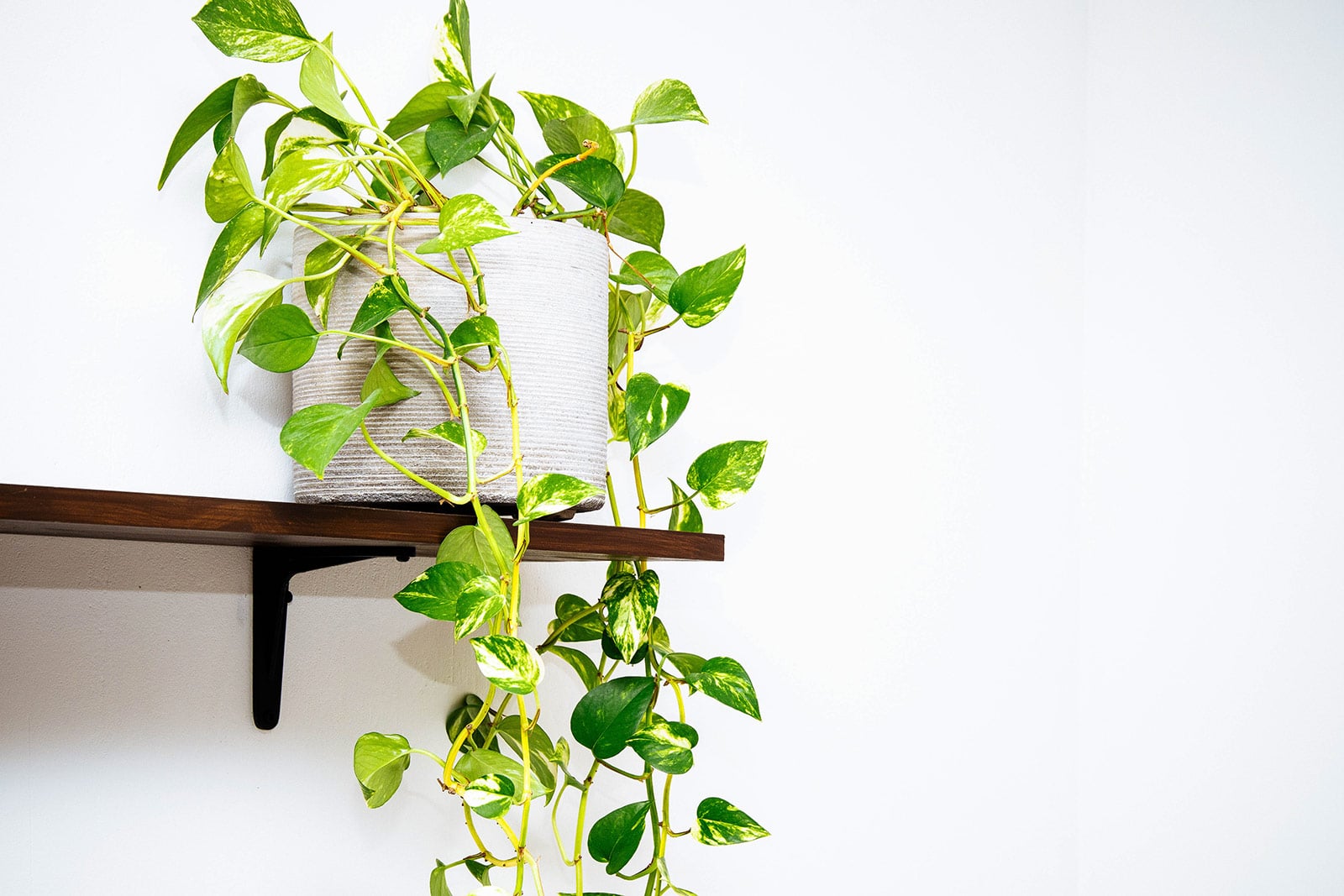You might be more familiar with this plant as devil’s ivy, but did you know it was given that name because it’s nearly impossible to kill? I don’t know about you, but any plant that’s hard to kill is a definite keeper as a houseplant!
The Marble Queen pothos (Epipremnum aureum) is a speckled plant that’s super easy to look after, which is why it’s wildly popular with both novice and experienced growers. If this is your first time caring for Marble Queen pothos, I’ve got everything you need to know in this in-depth guide on growing devil’s ivy indoors. Let’s dig in!
| Common name(s) | Devil’s ivy, devil’s vine, money plant |
| Scientific name | Epipremnum aureum* |
| Family | Araceae |
| Height and spread | Up to 3 feet wide and 10 feet long |
| Light | Low to bright indirect |
| Soil type | Well-draining potting soil |
| Water | Keep lightly moist |
* Be aware of the many incorrect or obsolete names that are often attributed to pothos, including Pothos aureus, Epipremnum mooreense, Rhaphidophora aureus, Scindapsus aureus, and Scindapsus Epipremnum.
Disclosure: If you shop from my article or make a purchase through one of my links, I may receive commissions on some of the products I recommend.
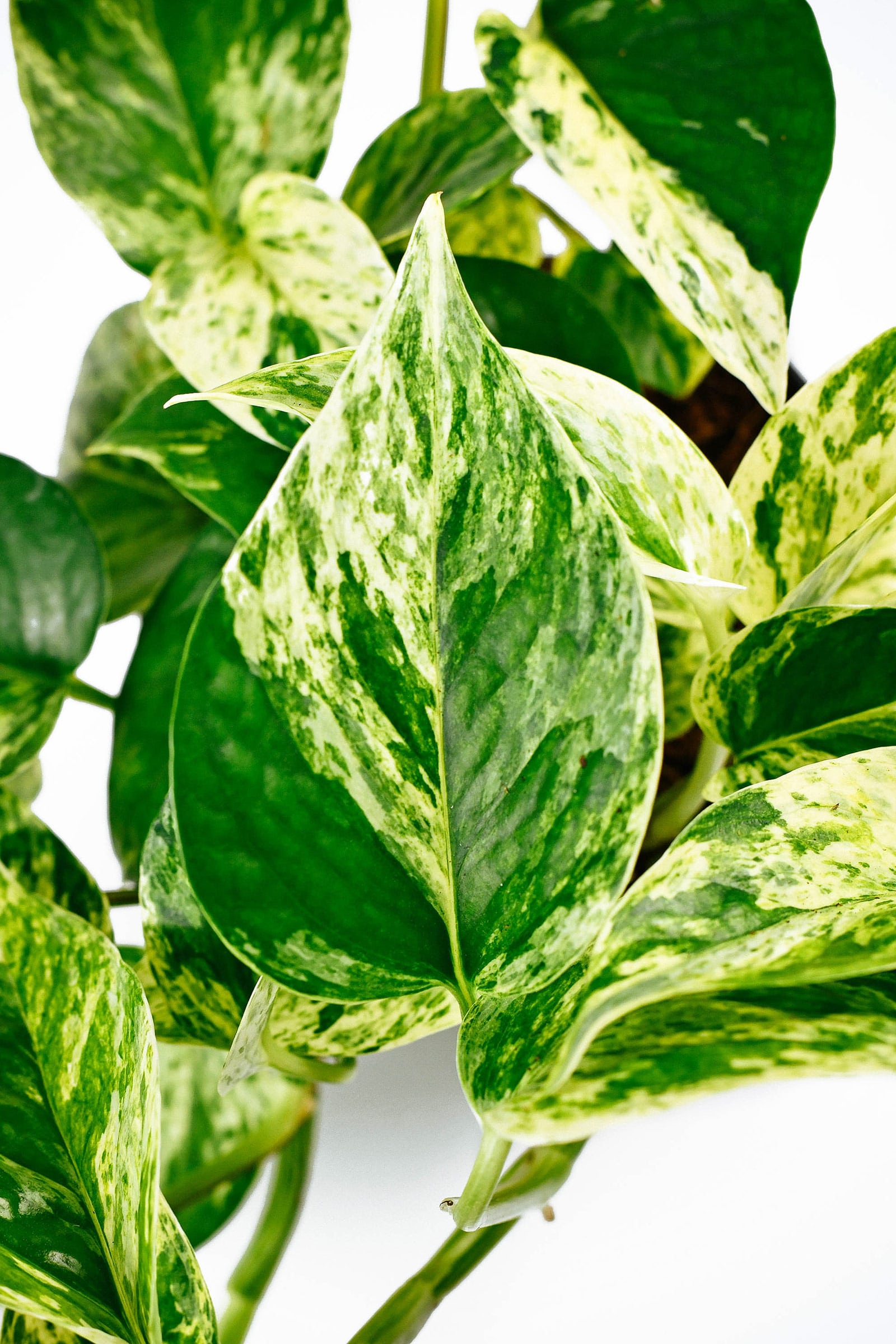
About Marble Queen pothos
Natural habitat
Epipremnum aureum is native to French Polynesia (specifically on the island of Moorea), but has become naturalized in other tropical and subtropical regions around the world, including northern South Africa, Australia, Southeast Asia, South Asia, the Pacific Islands and the West Indies.
Remember how I mentioned the plant is hard to kill? Well, it grows so quickly and so easily that it’s actually become an invasive species in many areas—hence the name “devil’s ivy.” Epipremnum aureum has thoroughly invaded forests in Sri Lanka and is starting to threaten Hawaii and South Africa.
Luckily, Epipremnum aureum can be tamed at home, but it’s always wise to keep your plant from “escaping” into your yard (and into the environment) by properly disposing of your pothos clippings.
Description
Like other pothos varieties, Marble Queen is an evergreen aroid plant that grows in a vining manner. It puts roots in the ground but uses trees as support to climb toward the light.
The Marble Queen cultivar has highly variegated light green leaves with fine cream mottling that reminds me of a stunning impressionist painting.
As a houseplant, pothos has small, heart-shaped leaves on thin vines that typically stay under 10 feet long. In the wild, however, pothos grows thick and heavy with huge leaves and vines that sometimes span up to 20 feet long!
Pothos can produce small (and rather unimpressive) flowers that look like those of any other aroid (such as African mask plants or Swiss cheese plants), but it’s rare to see it bloom indoors.
Where to buy
Marble Queen pothos vs. Golden pothos
Marble Queen and Golden pothos are two of the most common cultivars of Epipremnum aureum, and it’s easy to confuse them for one another at first glance.
The main difference you can see is in their variegation. Marble Queen pothos has much finer markings on lighter green leaves that resemble marbling. On the other hand, Golden pothos has medium to dark green leaves with splashes of yellow.
Taxonomy
Pothos has had many scientific names over time, and was classified for a while as Epipremnum pinnatum. Later it was discovered that pothos was a different species altogether, but the two are often still mistaken for each other, especially now that pinnatum is becoming more popular.
Related: What Are Cultivars, Varieties, Hybrids and More: Layman’s Guide to Plant Taxonomy
(This crazy confusion over names isn’t exclusive to pothos, by the way. Other plants like Calathea vs. Goeppertia have also been mixed up due to scientific reclassifications.)
To tell them apart easily, just look at the leaves: Epipremnum aureum is more rounded.
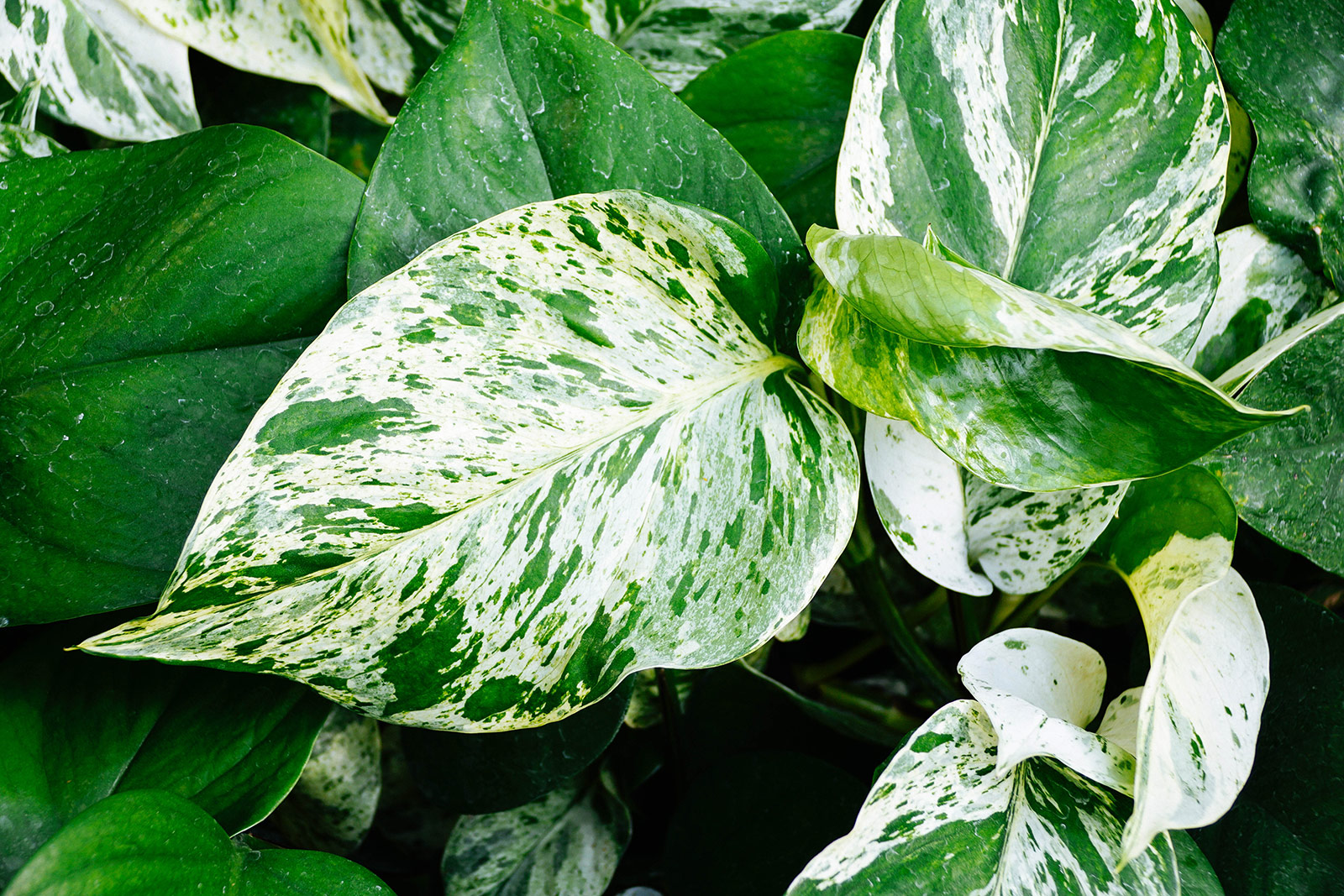
Caring for Marble Queen pothos
Light and temperature
True to its reputation as a low-maintenance houseplant, pothos isn’t too fussy about light and it’s often touted as a no-light or low-light plant to keep in the home.
This is definitely the type of plant to go for if you want to brighten a corner that most other plants would be unhappy in, but there’s a big “but”—Marble Queen, in particular, still needs sun (there’s no such thing as “no-light” plants unless they’re fake) and if this cultivar doesn’t get enough light, the leaves may revert to all green and lose their beautiful variegation.
Make sure you put your pothos in a room that receives a medium amount of natural light (even if it’s from a window on the other side of the room). Though it can tolerate low-light conditions, too little light will slow the growth of your plant considerably (in addition to causing the plant to produce all green leaves).
(This is a common issue with other variegated houseplants, like Monstera Borsigiana, Pink Princess Philodendron, and Stromanthe Triostar.)
For that reason, I recommend placing your Marble Queen near a window. With proper acclimation, it can handle quite a bit of sun; however if you notice the leaves starting to pale, that’s a sign your pothos is getting too much direct sun.
Because of it’s tropical origins, Marble Queen more or less likes the same temperatures we do. It thrives between 65°F to 85°F and won’t tolerate temperatures under 55°F. Please don’t let the plant sit in a cold environment for too long, as this will stunt its growth.
Water and humidity
Again, this is where pothos is super ideal for new houseplant enthusiasts: It doesn’t need constant watering and happily grows in soil that’s a little on the dry side. If you sometimes forget to water your plant, that’s okay because pothos is pretty drought tolerant!
(In fact, if you tend to have trouble remembering when to water, pothos is a great option as a plant that grows in water, no soil needed!)
So how do you know when it’s time to water? Do the finger check: If the top few inches of the soil feels dry, give it a drink.
When watering, pour fresh water slowly and lightly from above the plant. Take your time, letting the water soak into the roots and completely out of the drainage hole.
Many other popular vining houseplants (like arrowhead plants and mini Monsteras) come from tropical regions and love a lot of humidity. Marble Queen pothos is no different, preferring slightly higher than average indoor levels.
Ideally, your pothos should live in a room with approximately 40 percent to 60 percent humidity. (You can use an inexpensive digital humidity meter like this one to check your home.) Because pothos loves warmth and humidity, it appreciates being placed in bathrooms or kitchens with windows.
Soil and planting
Marble Queen pothos isn’t too demanding when it comes to soil, though it likes a rich and well-draining mixture that’s a bit on the acidic side.
Honestly, your plant will be happy in a standard off-the-shelf potting soil, but if you tend to overwater, it’s a good idea to mix 75 percent potting soil with 25 percent perlite to create a looser medium.
As for planting, Marble Queen does fine in any pot with a drainage hole. Which one you choose will influence how the plant grows, so think about the look you want to go for:
- A hanging planter lets the vines trail down. The leaves stay smaller but create a beautiful waterfall effect.
- A regular pot with a plant totem lets the vines climb up. Pothos plants that are allowed to climb actually grow larger leaves, mimicking their behavior in their native habitats. This gives them a completely different look and helps them look more lush.
- A regular pot against a wall lets the vines drape across a wall or other object. You can secure the vines with Command hooks or twine to create a wild jungle feel in your home.
Recommended products for Marble Queen pothos care:
- Good Earth Organics Premium Potting Soil
- FoxFarm Ocean Forest Potting Soil
- Perfect Plants Organic Perlite
- Totem Monkey Extendable Coir Moss Poles
- ThermoPro Digital Hygrometer
Fertilizing
Applying fertilizer to Epipremnum aureum is optional and unnecessary to keep this plant luscious. However, if you want to promote strong growth, regularly fertilizing the plant once or twice a month can help. Just apply fertilizer sparingly during the growing season (spring and summer months) with a liquid houseplant fertilizer, diluted to half strength.
If your Epipremnum aureum starts to look sad, resist the urge to fertilize in an attempt to perk it up. This is when the plant is at its most vulnerable, and your best course of action is to fix the underlying problem (whether it be underwatering, overwatering, or too much direct sun.)
Recommended fertilizers for Marble Queen pothos:
- Houseplant Resource Center Liquid Fertilizer for Houseplants
- Instant Biologics Instant Plant Food (Fizzing Nutrient Tablets)
- Maxsea All-Purpose Seaweed Plant Food
Pruning
Pothos generally doesn’t need any pruning, but aggressively trimming the long vines every few months can keep your plant looking full and bushy. You can use the stem tip clippings to easily start new plants (which I go over in more detail below, in the section on pothos propagation).
Dividing or repotting
Epipremnum aureum doesn’t mind being a little rootbound and snug in its pot. But if you notice the leaves drooping a lot (even after watering) and roots creeping out of the drainage hole, that likely indicates the plant is too rootbound, causing the soil to dry out too quickly.
Most plants can thrive well in the pot they come in for up to a year. To check when your plant probably needs to upgrade to a larger pot, feel the soil and observe whether it’s loose or tightly packed. If it’s very firm, it may be time to repot your Epipremnum aureum. Keep reading to learn how to do this successfully!
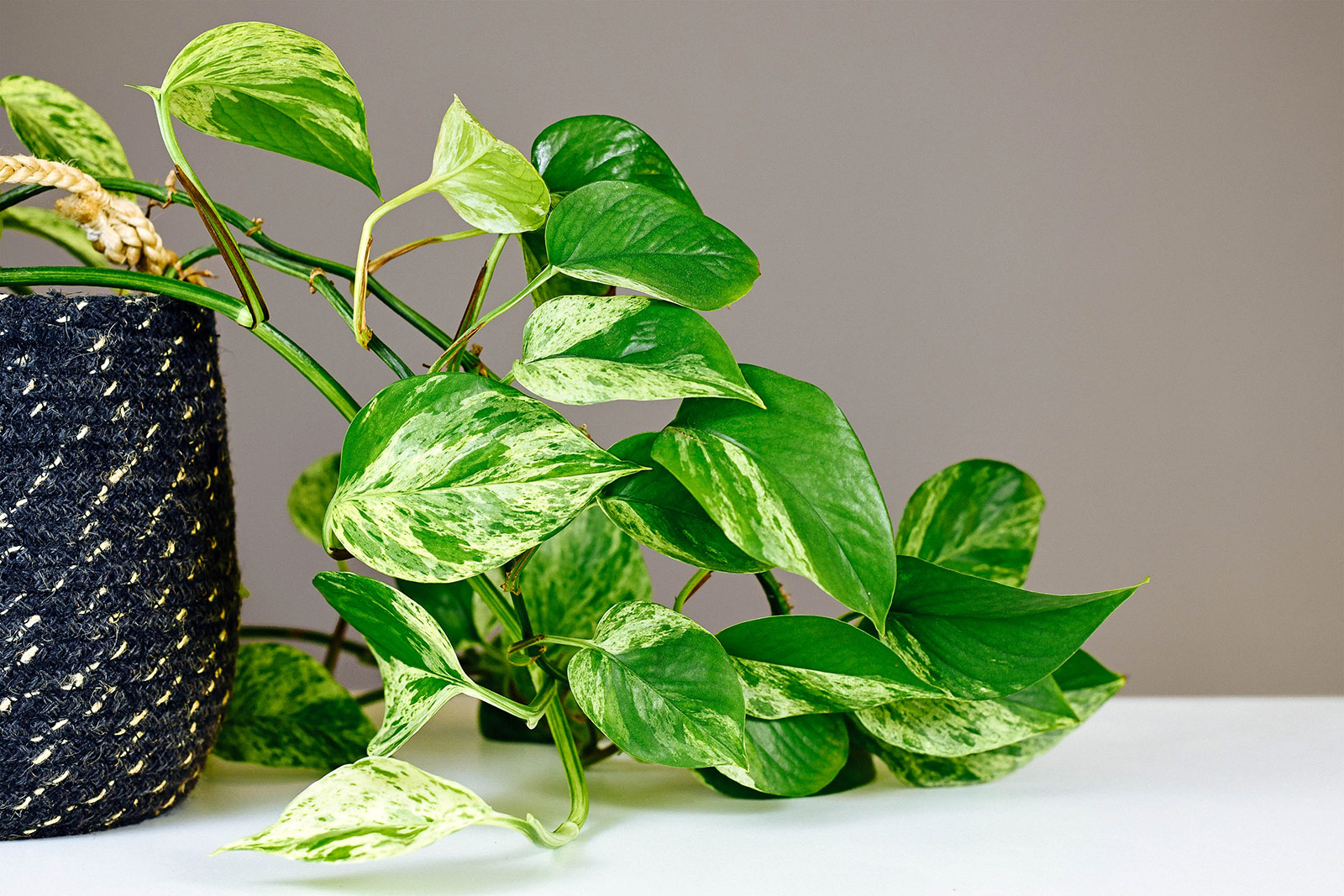
How to repot a Marble Queen pothos
What you’ll need
- Your Marble Queen pothos
- A bigger plant pot than this pothos is already in (about 2 inches larger)
- A small trowel
- Fresh potting soil
Before you repot, make sure you thoroughly water the plant the day before so that it’s ready to be repotted.
- To remove the plant from the pot you’re moving it from, turn it sideways, gently grasping it by the stems. Then, tap the pot’s bottom until the plant and soil loosen, sliding out.
- Loosen up the soil around the plant and carefully spread the roots.
- Scoop in some fresh potting soil and place the plant in the pot so that the roots are no more than an inch below the rim. Pour more potting soil into the pot, around the plant’s sides, and a little around the main stem. Compact the soil by gently pressing down on it, ensuring the pothos is firmly upright and centered.
- Place the newly potted plant in the sink and water thoroughly until all the excess water flows freely out the drainage hole. Put your Marble Queen pothos somewhere with low to bright indirect sunlight with moderate to high humidity and you’re done!
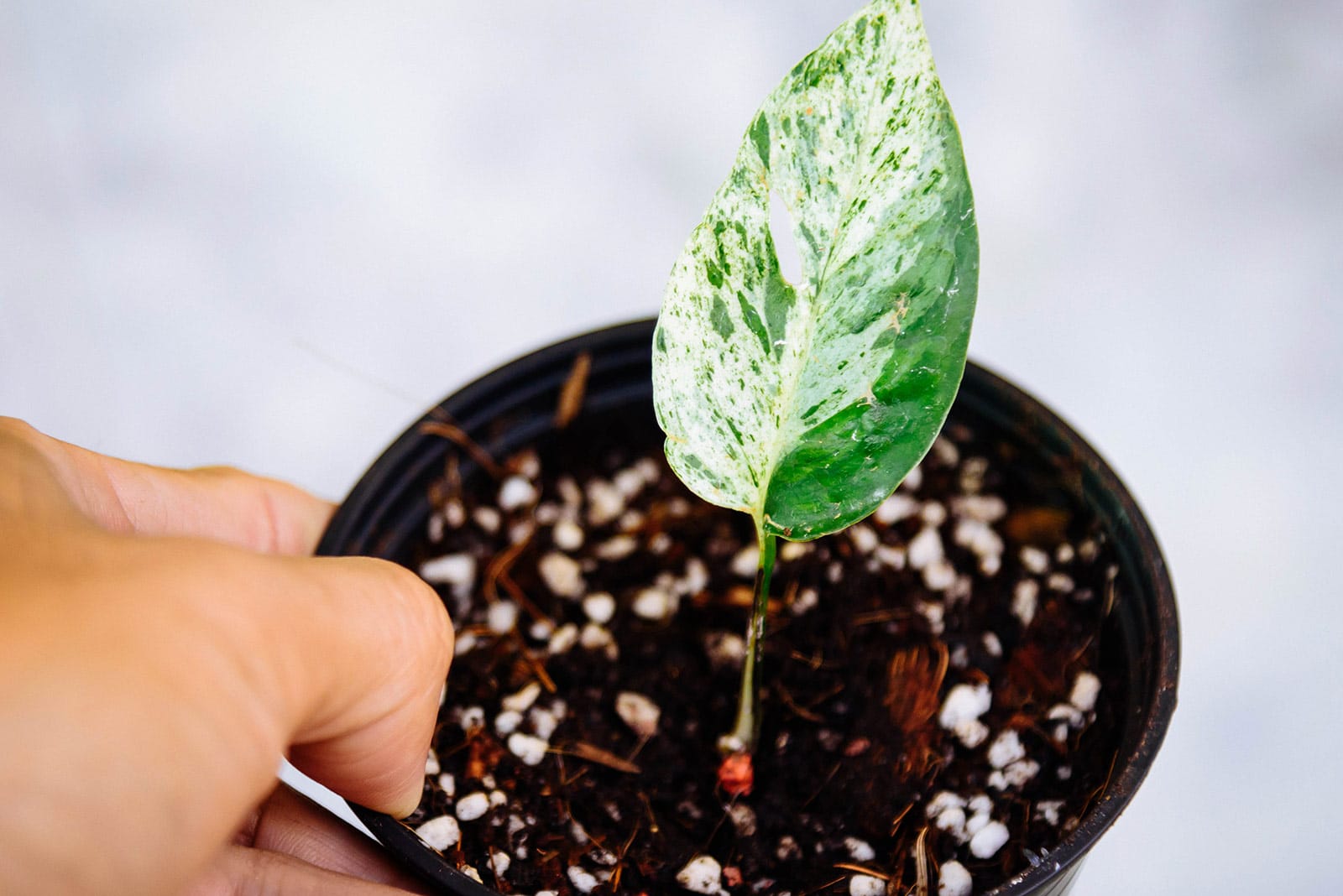
Propagating Marble Queen pothos
Pothos is a beginner-friendly plant; it can be easily propagated to increase your pothos collection. To do this effectively, you’ll need to take stem cuttings.
This method is brilliant to promote denser growth on your original pothos plant. If you’re looking for gifts to give to plant-loving friends, propagating is a clever way to provide them with this gorgeous variegated plant.
Follow the steps below to propagate your pothos plant.
- Look at your Marble Queen pothos and count on a stem until you are no less than 4 nodes down. Next, cut off the stem, leaving you a branch with at least 4 nodes on it. If you want to give the branch a good chance of thriving, leave more than 5 nodes on the cutting.
- Take off the two bottom leaves from every cutting, exposing the nodes. Make sure there are at least two leaves at the other end of the cuttings.
- Fill a glass jar with water and put your cuttings in them so that the bottoms are fully submerged. Ensure that the top leaves stay above the water.
- Find a spot that gets medium to bright indirect light, and place the jar(s) here. Change the water weekly, making sure it’s fresh. Roots should start to appear in the water at around two to three weeks.
- When you notice that the roots are at least 1 inch long, the cuttings are ready to be planted in potting soil. If you want to make the mother plant fuller, you can transplant the rooted cuttings around the mother plant. Alternatively, you can encourage the new Marble Queen pothos to grow on their own in individual pots. Whichever replanting method you choose, make sure the soil is moist beforehand and gently pat down any loose soil around the main stem. Patting the soil ensures the tiny plants are fully supported.
- Place the new transplants in medium to bright indirect light, keeping the soil lightly moist after replanting. Once the plants have grown a little larger, they can be moved elsewhere in your home (including spots that are a little darker).
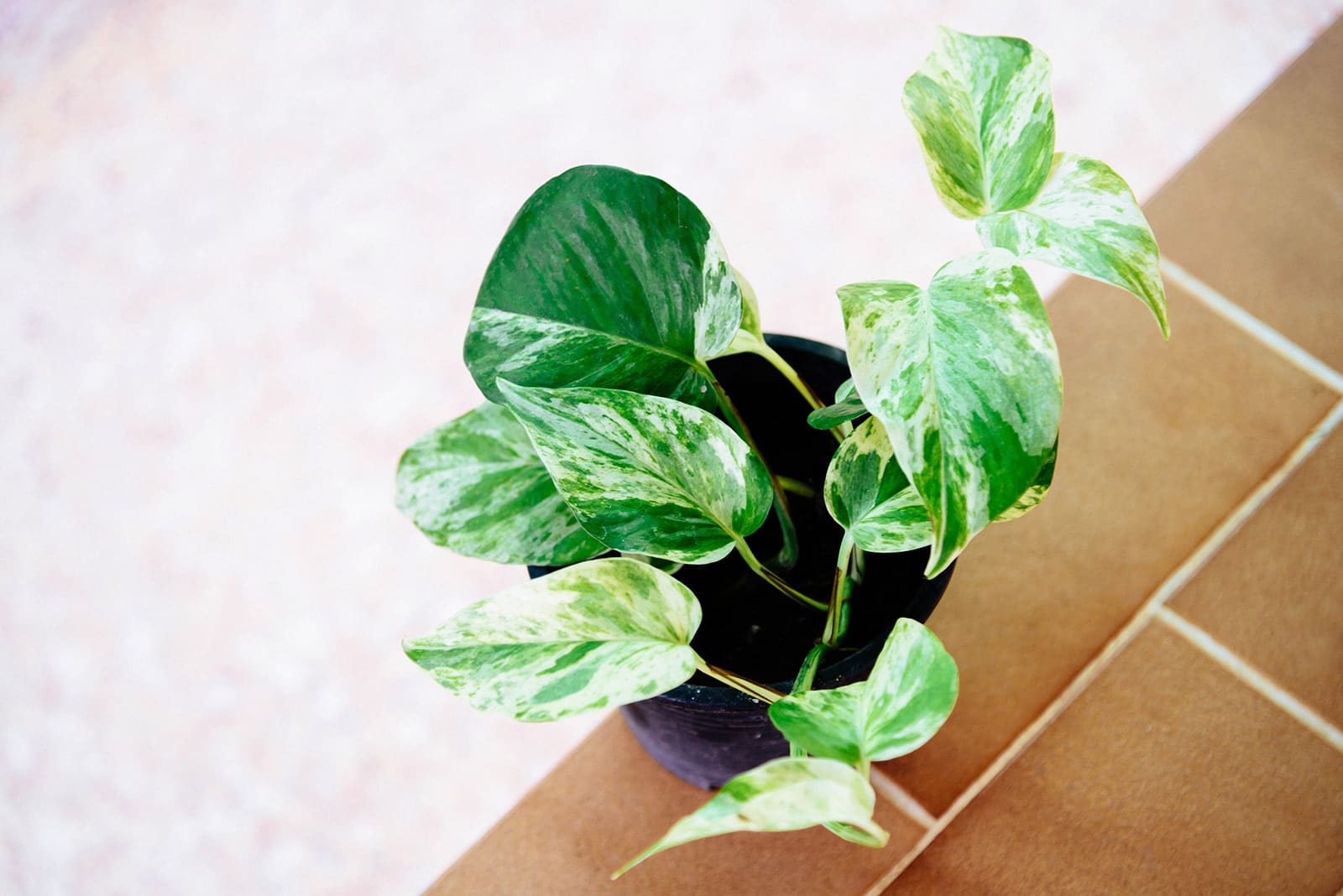
Common problems with Marble Queen pothos
Pothos with browning leaves
If the leaves on your Marble Queen pothos are browning, this could be caused by any number of problems: underwatering, overwatering, low humidity, sun damage, or cold damage.
To solve these common issues:
- Make sure you keep the soil lightly moist and don’t let the soil go bone dry for more than a few days.
- Use a looser potting soil if you tend to have a heavy hand with watering.
- Keep the plant away from drafty windows or heating vents, which can strip the air of humidity
- Acclimate the plant to full sun if it previously lived in a darker spot in your home.
- Remember, pothos is a tropical plant, so it won’t be happy if temperatures consistently dip below 55°F.
Pothos with brown leaf tips
If only the leaf tips are turning brown, this may be due to underwatering, low humidity, or low-quality tap water. Sometimes, this is an indication of sun damage if your pothos is too close to a window that gets harsh direct sun all day.
If you notice brown leaf tips in winter, a likely cause is dry air. Try moving your plant away from the fireplace, heating vent, or other heat source.
Pothos with yellowing leaves
The leaves on your pothos may become yellow for one of three reasons: overwatering, exposing the plant to direct sunlight regularly, or neglecting to place your plant in enough sunlight.
As the reasons for yellowing vary, it can be tricky to figure out why your pothos is looking sad. Scroll back up and go over this guide again to help you care for your plant properly.
Pothos with droopy leaves and dry soil
Oops, you’ve waited too long to water! Give your plant a thorough watering and it’ll perk up again. If you have a tendency to forget a lot, try placing your plant in a lower light (or more humid) location so it retains moisture longer.
Pothos with droopy leaves and moist soil
If the leaves on your pothos plant are still droopy despite your best watering efforts, this may be because you’ve overwatered and the roots are rotted, unable to take up more water.
If this is the case, remove the plant, cut off the rotted ends, and repot in fresh potting soil (with a handful of perlite for better drainage).
Pothos with bugs
Like any houseplant, pothos is susceptible to pests like spider mites, fungus gnats, mealybugs, and thrips. You can use an insecticide (like my homemade insecticidal soap) to treat these pests more naturally.

Common questions about Marble Queen pothos plant care
Do Marble Queen pothos grow fast?
Marble Queen pothos will increase in size if it’s well looked after. Being exposed to medium to bright indirect light conditions, regularly fertilizing, and proper watering will accelerate the plant’s growth. Indoors, the vines can grow as long as 10 feet pretty quickly with good care.
It’s essential to place your pothos in an area that’s 40 percent to 60 percent in humidity levels, too, to give it the best chance of thriving. Bathrooms and kitchens are typically great places to grow Marble Queen pothos because they’re often very humid.
If your plant seems to have slowed its growth or isn’t thriving as much as you expect, it’s best to reexamine your care routine. It could be that the plant is in an area that’s too dark, it’s not drying out enough between waterings, or it’s stunted by pests.
How long does it take for Marble Queen pothos to grow?
In ideal conditions where it’s well cared for, Marble Queen pothos can grow up to 18 inches a month! On average, it will get to be approximately 5 feet long as a houseplant.
How often should I water my Marble Queen pothos?
The recommended frequency is about once a week in summer, though this will depend on your particular potting soil, amount of sunlight, and humidity levels. Between waterings, make sure you’re letting the top few inches of the soil fully dry out.
Allowing the soil to dry out helps prevent root rot, which can cause your pothos plant to die.
Does Marble Queen pothos like to be misted?
Your pothos will love a little misting every now and then! Misting your plant helps keep the leaves clean and fresh.
If you want to give the plant extra pampering, sponge water onto the leathery leaves and wipe them off to remove any accumulated dust.


